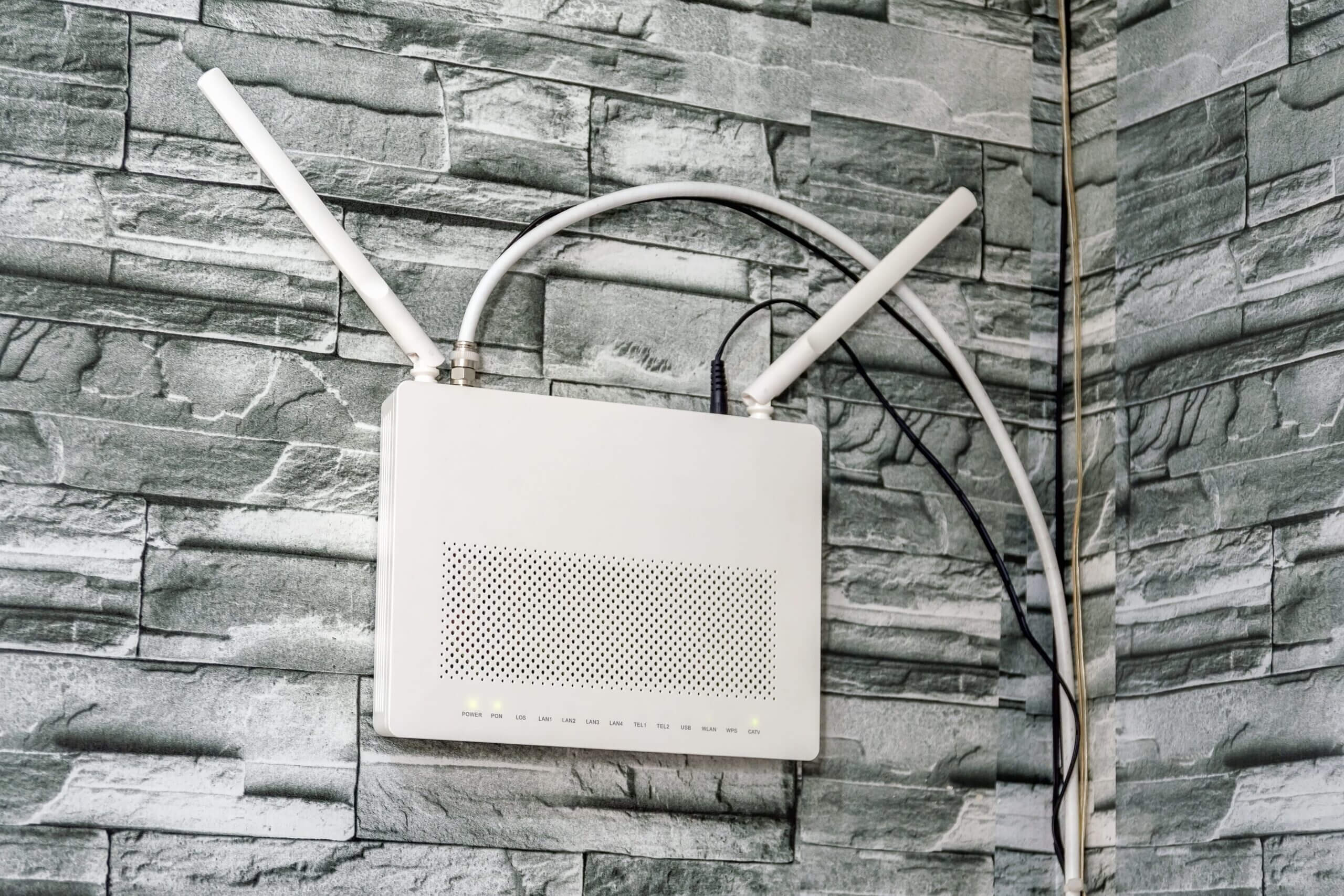Wireless Site Surveys
A site survey is the first step to any cable installation. Learn all about how it works here!
How Site Surveys Are Performed
Typically, an outside company can send in an expert to perform the survey itself. From there, you can get an idea of how your WLAN performs and what you’ll need to do to install a wireless network that has optimal performance for your needs.
Before you dive right into the wide world of wireless site surveys, there are a few terms you should familiarize yourself with. These are both common and important terms in wireless network surveys, and you may hear them in connection with your own survey results.
Terms to Know for Site Surveys
Signal-to-Noise Ratio
The signal-to-noise ratio, or SNR, is the level of desired signal in proportion to the background noise caused by interference.
WLAN
WLAN stands for “wireless local area network.” It connects two or more devices to the local network.
Wireless Access Point
A wireless access point is a place where an end user can access the wireless network, like a router.
RF Interference
“RF” stands for “radio frequency” interference. RF interference can be caused by electromagnetic interference and interrupt connections.
Hotspots
Hotspots use Wi-Fi to allow users to join the local area network (LAN).
Quality of Service
Quality of service measures the performance of the computer network with measurements like packet loss, bit rate and more.
These are just a few of the technical terms that you might run into during the initial survey and the entire network deployment process. But knowing what they stand for can be an advantage when you have to choose a survey provider.
Who Performs the Survey
A site survey can be performed by an IT services company, site survey provider or a data cabling company before installing cabling or deploying a network. During the survey, the surveyor will use specially designed software to measure your WLAN’s metrics and performance throughout the premises — be it one office building, a school campus or an apartment complex.
A site survey will measure how much electromagnetic or RF interference is present and important metrics like traffic, signal strength and noise on a network. This involves using a few different tools to gather the right information and data.
Site Survey Tools
One thing to remember about a wireless survey is that it’s not quite the same as an architectural survey. With some site surveys, software will run a predictive analysis on the metrics for the network itself. This software can provide detailed information on a signal strength and even display a heatmap to illustrate it.
Specialized hardware is also required for analyzing the RF spectrum as part of the survey. These spectrum analyzers are often small and portable for the surveyor to get an accurate reading and data.
What Is the Purpose of a Site Survey?
Why go to the trouble of hiring a company to survey your network? It’s actually an important step to upgrading your entire IT infrastructure.
When a Survey Is Needed

A site survey is important because it establishes the starting point for your network before anything is installed. Any kind of cabling installation will need to run through the entire building or campus to ensure that the connection performs well and consistently, even with daily use. The data the survey collects paints an accurate picture of the current state of your network, so it can be improved with a new network.
What Happens During a Wireless Site Survey
During the survey itself, the surveyor will go through your entire building to determine your network’s strength, coverage and the amount of interference there is with your network. It also requires the surveyor or the survey provider to inspect the access points for your cabling. Sometimes, the survey may also include the stairwells, elevator and other less-used parts of the building that aren’t necessarily work areas.
A surveyor will take a spectrum analysis with their equipment to measure signal versus frequency.This process can involve creating a wireless heatmap of your network, physically inspecting the premises and performance tests. What actually happens can really depend on the kind of survey that’s being done.
There are few different types of site surveys that can be performed for a new network deployment. They differ in their exact execution, but still work to collect important data on your network.
The Three Types of Site Surveys

Passive
A passive site survey uses a wireless adapter and site survey software to listen in on the WLAN. It detects access points during the survey itself and temporary access points might be installed for this kind of survey.
Active
During an active survey, a wireless adapter that’s associated with an access point measures the performance for the network in one round trip. Metrics like packet loss and the time it takes data to send and be received can show you how well the network performs in detail.


Predictive
A predictive survey will actually use software and predictive analytics and a simulation to model the RF environment. Temporary access points can estimate coverage and later be used in the design phase for expected interference.
Predictive surveys are commonly used for wireless site surveys, using blueprints or floor plans to generate results. Sometimes, if necessary, an on-site predictive survey should be performed to make sure that the results are accurate.
Where a Site Survey Can Be Performed
A wireless site survey can be performed on a single office building or on a larger campus. Some more complicated campuses like hospitals or large universities may require a more in-depth, on-site survey in order to fully assess the network and all of the factors that need to be considered for a network upgrade.
Even if your business spans multiple buildings, you can still have a site survey completed just to have a good idea of where your network stands in its current state. If you find that your current network connection is slow and just not enough for your needs, you may need to fully invest in upgrading your network.
Download Your Wireless Site Survey Checklist
The Importance of Site Surveys
Why does performing a site survey matter? If an existing network is already in place, why can’t the data wiring company just use that? The answer is somewhat complex.
Data Visualization
Performing a thorough site survey and collecting data on coverage and channel usage helps the surveyor both map out the existing network and create a better design for the upgraded network.
With the right data, the surveyor and the IT services company can account for any spotty coverage in the network, neighboring access points, usage and more. If you know that certain areas of your building have poor coverage or none at all, installing an access point or adding to the infrastructure can solve that problem.
Planning for the Future
Another benefit of performing a wireless site survey is that it can help you plan for the future at your business. Your existing network, if it’s not performing adequately, can seriously hurt productivity and even put you at risk for longer periods of downtime if it can’t handle daily operations.

What to Watch Out for in a Site Survey
Performing a site survey involves both hardware and software to accurately map out a floor and building’s network. However, the survey itself may become useless or result in a poorly designed network infrastructure if inaccurate data is captured due to simple mistakes. To make sure the survey is fully accurate, ask for a full report of the data once it’s been completed.
Here are a few things to make sure your site survey covers.
What a Site Survey Needs
Proper Map Calibration
In a site survey, the site survey application or software will render a map of the floor of a building. A heatmap will then cover the rendered map. However, if the map is incorrectly scaled (too low or too high), then the heatmap isn’t accurate to the actual floor of the building. Why is this important? If your heatmap isn’t accurate, then neither will the signal coverage of your new network.
Accurate Coverage Mapping
When a surveyor uses a site survey application, there’s always a chance that the settings may be incorrect. “Signal propagation assessments” are what allows the survey to show coverage points in certain areas. However, if the assessment’s value is too high, the map could show acceptable signal levels when there’s actually little to no coverage at that location.
Valid Walking Paths
During an on-site survey, the surveyor will need to physically walk around the floors of your building. If the surveyor doesn’t get to all of the spaces on the floor plan, you’ll have an inaccurate picture of your coverage. When that happens, the map isn’t very useful because you don’t actually have full visibility on how strong your floor’s signal is.
What to Ask Before a Site Survey Begins
To ensure that everything goes smoothly during the survey, it can help to confirm a few things with the data cabling company. These questions will help you understand what you’re looking at later once the survey is completed. Knowing where you stand with your current network is important so you know the design of the new network will fit your needs.
Questions to Ask
Will the survey be active or passive?
Knowing what kind of survey will be performed can help you better interpret the data when it’s presented to you.
Will the survey cover areas like stairwells and elevators?
Sometimes, the service level agreement (SLA) doesn’t include a survey of less-commonly used areas like stairwells.
What parts of the building are in-scope for the survey?
“In-scope” areas of the survey are the specific areas included within the SLA. This may not always include areas like stairs and elevators.
What type of survey is being conducted?
You may want to know if the survey will cover voice as well as data, or only data.
Will the surveyor provide screenshots of the interference’s sources?
Having a clear picture of the source of your network’s RF interference can help contextualize where the new access points will be.
Does the AP hardware used for the survey match what will be purchased?
It’s important the adapter the surveyor uses matches the brand that will later be purchased for accurate results.
These questions deal specifically with the technical details of how the survey will be performed and completed, but you may also have questions about cost, time and labor. If these details haven’t been agreed upon in an SLA, you may want to establish one to protect your business.
Frequently Asked Questions
If you’re interested in installing structured cabling solutions at your business location, an experienced data cabling company will have the resources and expertise to make sure your network has all the support it needs. They can choose the right solutions to fit your business’s present and future needs.
Besides just being efficient and organized, structured cabling solutions can help you maximize your business’s productivity and make it easier for your IT team to troubleshoot and solve any issues that arise.
It can depend on how large the premises and network are. It can take a day, in many cases, to do a full wireless site survey.
It can depend on whether or not an SLA has been signed. Sometimes, the cost of the survey can be incorporated into the SLA.
You should in order to maximize performance of the new network. Any major overhaul or upgrade should involve a site survey for accurate data collection.
If you have the right equipment and software, it’s possible. However, an expert will know how to best interpret the data from the survey and use it during the design phase of network deployment.
A site survey will show you how your current network is performing in terms of speed and interference. This will help in identifying where coverage on the network is weakest.
Yes, if your network spans over a campus like at schools, colleges, hospitals, lab centers or apartment communities.
Environment can matter because it can influence how much RF interference there is and its source.
You can ask for the results and the complete report, or have the surveyor walk you through what the results and data mean.
A data cabling company or an IT services company can perform a site survey prior to installing and deploying your network.
What Happens After the Survey
What happens once the survey is complete for your building or campus? What’s the next step once you have your data? Here’s what you should do immediately after the survey is completed and later on to setup and deploy your new network.
Step 1: Design the Wireless Network
A site survey is the first step in deploying a new network. Designing that network is the next logical step. Two things the designer needs to establish are the average amount of WAPs needed and users that will be on the network.
A wireless network design will also need to take a few other factors into consideration like the network’s security, the environment the network will be used in and even the budget. Environment can influence how much RF interference is present and where it comes from, so the design phase has to take that into account to ensure the network is performing at top efficiency for daily use.
Step 2: Install the New Equipment and Cabling
After the design is finalized and approved, any new equipment or cabling will need to be installed. Adding WAPs can require additional cabling, as will adding in any new patch panels or racks as part of the overall cabling system and new network.

Step 3: Deploy the New Network and Test It
After everything is installed and moved into place, the next step is to test the network again to ensure its performing as expected. This is kind of like a quality assurance test for your network and an opportunity to troubleshoot any issues the data cabling team can identify. This test is a lot like the initial site survey, testing the network for coverage, speed and any other issues that might indicate interference and a poor connection for end users.
This post-deployment survey is where an accurate initial survey can really come into play. Having accurate data will show a comparison in coverage, channel usage and more between the old and the new network.
Getting a Site Survey for Your Business
#1: Determine What You Need for Your Network
As with any major change to your business, you need to know what you want and what you need. If your business is expanding and you expect it to grow faster in the near future, a full network upgrade will keep pace with your IT needs. If, on the other hand, you’re moving into a brand-new building and need to deploy a network for the first time, it helps to know how much you might grow in the future. If you plan on adding new tools, especially for telecommunications, you need a network that can handle that, too.

#2: Do Your Research
Some data cabling companies may also specialize in certain industries, like healthcare and education. If your situation involves multiple buildings across a large campus, you may want to consider an IT services provider with plenty of experience working with larger-scale networks. They’ll have the insight and tools needed for your particular situation.
Security for any network is a concern. But if you handle sensitive information and data, it’s even more important to secure your network from data loss or a security breach. Downtime is also another crucial thing to consider for your network. You want as little downtime as possible, so your network needs to be technologically sound.
#3: Decide If You Need an SLA or Not
Once you’ve narrowed down your search, you may need a service-level agreement, or SLA. An SLA is an agreement between you and a vendor on what services they’ll be providing you, including the quality of service and what happens if that level of quality isn’t met by the vendor. You can specify how much uptime you expect from your network and how much downtime is acceptable on an annual basis. With these kinds of set expectations and goals, you and the IT services company will be clear on what services will be rendered.

#4: Prepare Your Staff for the Survey
Once you’ve selected the company for your site survey, you should prepare your staff and let them know what to expect the day of the survey itself. Since a surveyor and possibly a team will be on the premises, it’s also helpful to ensure that they can access all the work areas in the building or on the campus.
The surveyor will also need to be able to access any vents or points of entry for interior cable. If they can’t find any naturally occurring points, they may need to make one. If you find this to be too intrusive to the workday and productivity, you may want to arrange for your staff to leave the work areas during the actual survey.
Conclusion
A site survey will help your overall network deployment process but also show you where you currently stand with your network’s performance. Any large IT project should involve some kind of data collection to ensure quality of service, but when it comes to overhauling your IT infrastructure, you definitely want to perform a site survey.
A reputable data cabling company will go the extra mile to ensure your survey’s results are as accurate as possible. Not only does it make it easier to design the new network and cabling, it also helps you as the business owner compare performance once the new network is deployed.
